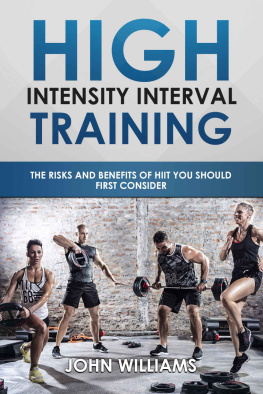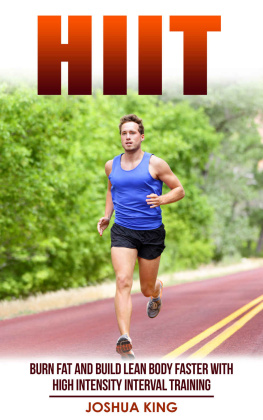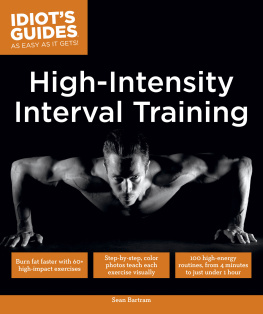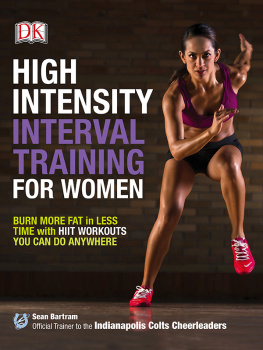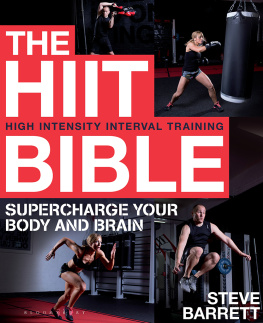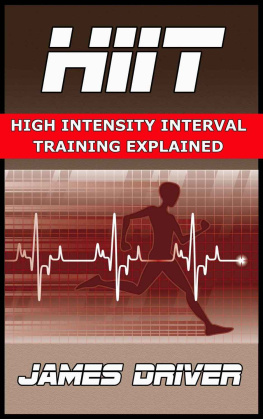
Lucy Wyndham-Read
HIITHigh-Intensity Interval Training
Meyer & Meyer Sport (UK) Ltd.

Contents
Imprint
2015 by Meyer & Meyer Sport (UK) Ltd.
Aachen, Auckland, Beirut, Cairo, Cape Town, Dubai, Hgendorf, Hong Kong, Indianapolis, Manila, New Delhi, Singapore, Sydney, Teheran, Vienna
Member of the World Sport Publishers Association (WSPA)
978-1-78255-394-6
www.m-m-sports.com
ISBN 978-1-78255-394-6
The contents of this book were carefully researched. However, all information is supplied without liability. Neither the author nor the publisher will be liable for possible disadvantages or damages resulting from this book.
If you are new to exercise you should always consult your doctor before starting a new workout!
INTRODUCTION
As a fitness trainer and author I have been involved in this industry for over 20 years, and I have seen many fitness fads and crazy diets, which I have known would fade out fast. They may be unrealistic to sustain, overcomplicated, or too demanding on the body, and of course some would always require that you invest in an expensive piece of equipment to perform the workout. Let me tell you the top fitness secret: The best bit of gym equipment ever is your own body, and for every exercise you have ever done in the gym, I can show you how you can replicate it at home and in a more effective waybut that is another book. (Though I will share this in here as well.)
Years before it gained the name HIIT, I had been using this particular method of training with all my clients and had seen incredible results. Having spent some time in the army, where this method of short intervals was used and where I came to develop my highest level of fitness, I was well aware of how successful it was. And now I would only ever train using HIIT for the simple reason that it works.
Because it is based on the key most important principle of all, which is INTENSITY, it is also QUICK, and the best bit is that it is EFFECTIVE. This then leads to RESULTS, which keep you MOTIVATED. You are then hooked. This is one habit that will stay with you for a lifetime.
In this book I will explain how to do the workouts and how to monitor the intensity, as well as examine nutrition and motivation.
PART 1
GETTING STARTED & UNDERSTANDING HIIT
1 HOW HIIT WORKS
HIIT stands for high-intensity interval training, which is also referred to as high-intensity intermittent exercise, and also sometimes called fast training. This method of training can be applied to any form of fitness, from cycling or swimming to home circuits, and the beauty of it is that it is simple and gets amazing results quickly, saving you time. As intensity is key, the first thing we should look at is a chart you can use to guide and assess your intensity levels known as the Rate of Perceived Exertion scale (or RPE scale). This is one of the best tools you can use for fitness, and we will use this scale throughout the book.
It is based on a scale of 1-10. A rating of 1 would be how you feel when you are sitting, so relaxed and not exerted at all! The other end of the scale would be a level 10, feeling physically exerted to your maximum.
Using this chart allows you to continually assess if you are working out at the right level. We will mainly be working between levels 4 through 7 in the book and will venture to level 8 in only a couple of the workouts. Each workout will reference the RPE level you should be exercising in.
TWO EXAMPLE WORKOUTS
Workout 1: 45-Minute Power Walk
This workout is basically a brisk walk, which, based on the scale of intensity, would be at level 4 (moderate intensitysee chart on p. 33). This pace is maintained for the entire 45 minutes. This is still a very valuable workout with health and fitness benefits.
Workout 2: 15-Minute HIIT Power Walk
This workout would consist of 2 minutes walking at a brisk pace, which on the scale of intensity chart would measure 4.5, then 1 minute walking as fast as you can, pushing the intensity up to level 6 to 7.5. The intensity would be feeling very hard. You repeat this ratio a total of five times, and the benefits are massive. For those short 1-minute intervals you will have pushed yourself to the maximum, and this is how the body gets fitter and stronger, producing amazing results. The other effect of this workout is that you create an EPOC effect, whereas workout 1 does not. More details on EPOC in the next section. So out of the 2 workouts, the one that will burn more fat and have a much bigger impact is workout 2.
Burn more fat in less time
If your goal is to burn fat and increase your fitness, then intervals should always be part of your program. Besides being a quick method to getting in a great workout, intervals are extremely effective for transforming your physique. Incorporating intense bursts of high intensity with short recovery segments allows you to keep the workout intensity high while still maintaining good form. The magic of high-intensity interval training lies in its ability to keep you burning fat even after you leave the gym. In short, your body isnt able to bring in enough oxygen during periods of hard work; therefore, you accumulate a debt of oxygen that must be repaid post-workout in order to get back to normal. The resultyour metabolism is revved up for hours after you have done your workout. Fitness specialists refer to this phenomenon as excess post-exercise oxygen consumption, or EPOC. The great news is that its very doable to slot these highly effective quick workouts into any busy lifestyle, and this book gives you plenty workouts to choose from. So those days when you are super busy, you can still fit in the quick 5-minute HIIT workout. No matter how booked your diary gets, you can always find the time.
2 HOW YOUR BODY MOVES
A very important aspect of any workout plan is to use as many planes of movement as you can to get great results.
I see so many workouts that only ever focus on one range of movement, and the result of this is overloading center muscle groups, causing injuries, and negatively affecting posture. And if body sculpting and toning is what you want, then using the three ranges is essential; it nips and tucks you in from every angle.
The three planes are:
Sagittal (which is forward and backward motion); this is the most typically used plane.
Lateral, also referred to as frontal (which is sideways movement).
Transverse (which is twisting and rotational movement).
I like to explain to my clients and in my books and apps just how the body works when we are exercising, because I believe the more you understand what you are doing, the more you engage with your workouts.
Knowledge is Power
LETS LOOK AT THE SAGITTAL PLANE
The sagittal plane is the most common plane of movement that we do not only in exercise, but also in day-to-day life; this is simply moving the body forward or backward.


